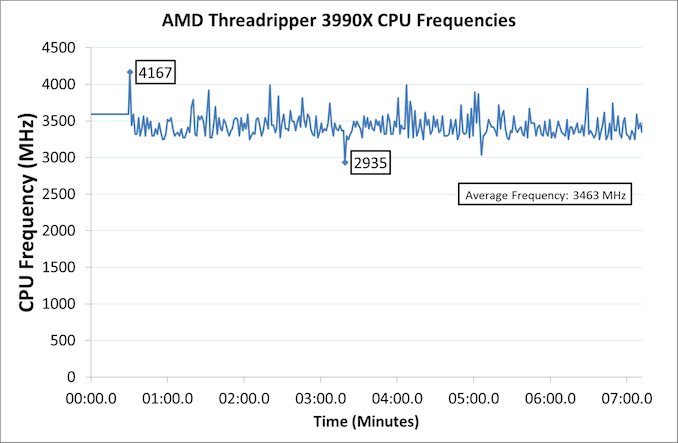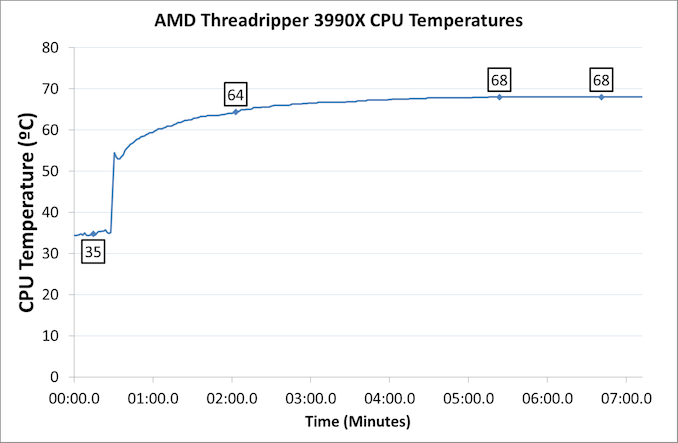The 64 Core Threadripper 3990X CPU Review: In The Midst Of Chaos, AMD Seeks Opportunity
by Dr. Ian Cutress & Gavin Bonshor on February 7, 2020 9:00 AM ESTFrequency, Temperature, and Power
A lot of questions will be asked about the frequency, temperature, and power of this chip: splitting 280W across all the cores might result in a low all-core frequency and require a super high current draw, or given recent reports of AMD CPUs not meeting their rated turbo frequencies. We wanted to put our data right here in the front half of the review to address this straight away.
We kept this test simple – we used our new NAMD benchmark, a molecular dynamics compute solver, which is an example workload for a system with this many cores. It’s a heavy all-core load that continually cycles around the ApoA1 test simulating as many picoseconds of molecular movement as possible. We run a frequency and thermal logger, left the system idle for 30 seconds to reach an idle steady state, and then fired up the benchmark until a steady state was reached.
For the frequencies we saw an ‘idle’ of ~3600 MHz, which then spiked to 4167 MHz when the test began, and average 3463 MHz across all cores over the first 6 minutes or so of the test. We saw a frequency low point of 2935 MHz, however in this context it’s the average that matters.
For thermals on the same benchmark, using our Thermaltake Riing 360 closed loop liquid cooler, we saw 35ºC reported on the CPU at idle, which rose to 64ºC after 90 seconds or so, and a steady state after five minutes at 68ºC. This is an ideal scenario, due to the system being on an open test bed, but the thing to note here is that despite the high overall power of the CPU, the power per core is not that high.
This is our usual test suite for per-core power, however I’ve condensed it horizontally as having all 64 cores is a bit much. At the low loads, we’re seeing the first few cores take 8-10W of power each, for 4.35 GHz, however at the other end of the scale, the CPUs are barely touching 3.0 W each, for 3.45 GHz. At this end of the spectrum, we’re definitely seeing AMD’s Zen 2 cores perform at a very efficient point, and that’s even without all 280 W, given that around 80-90W is required for the chipset and inter-chip infinity fabric: all 64 cores, running at almost 3.5 GHz, for around 200W. From this data, we need at least 20 cores active in order to hit the full 280W of the processor.
We can compare these values to other AMD Threadripper processors, as well as the high-end Ryzens:
| AMD Power/Frequency Comparison | |||||||
| AnandTech | Cores | CPU TDP | 1-Core Power |
1-Core Freq |
Full Load Power/core |
Full Load Freq |
|
| 3990X | 64 | 280 W | 10.4 W | 4350 | 3.0 W | 3450 | |
| 3970X | 32 | 280 W | 13.0 W | 4310 | 7.0 W | 3810 | |
| 3960X | 24 | 280 W | 13.5 W | 4400 | 8.6 W | 3950 | |
| 3950X | 16 | 105 W | 18.3 W | 4450 | 7.1 W | 3885 | |
The 3990X exhibits a much lower power-per-core value than any of the other CPUs, which means a lower per-core frequency, but it isn’t all that far off at all: less than half the power for only 400 MHz less. This is where the real efficiency of these CPUs comes into play.













279 Comments
View All Comments
HStewart - Friday, February 7, 2020 - link
One note on render farms, in the past I created my own render farms and it was better to use multiple machines than cores because of dependency of disk io speed can be distributed. Yes it is a more expensive option but disk io serious more time consuming than processor time.Not content creation workstation is a different case - and more cores would be nice.
MattZN - Friday, February 7, 2020 - link
SSDs and NVMe drives have pretty much removed the write bottleneck for tasks such as rendering or video production. Memory has removed read bottleneck. There are very few of these sorts of workloads that are dependent on I/O any more. rendering, video conversion, bulk compiles.... on modern systems there is very little I/O involved relative to the cpu load.Areas which are still sensitive to I/O bandwidth would include interactive video editing, media distribution farms, and very large databases. Almost nothing else.
-Matt
HStewart - Saturday, February 8, 2020 - link
I think we need to see a benchmark specifically on render frame with single 64 core computer and also with dual 32 core machines in network and quad core machines in network. All machines have same cpu designed, same storage and possibly same memory. Memory is a question able part because of the core load.I have a feeling with correctly designed render farm the single 64 core will likely lose the battle but the of course the render job must be a large one to merit this test.
For video editing and workstation designed single cpu should be fine.
HStewart - Saturday, February 8, 2020 - link
One more thing these render tests need to be using real Render software - not PovRay, Corona and Blender.e
I personal using Lightwave 3D from NewTek, but 3DMax, Maya and Cimema 3d are good choice - Also custom render man software
Reflex - Saturday, February 8, 2020 - link
It wouldn't change the results.HStewart - Sunday, February 9, 2020 - link
Yes it would - this a real 3d render projects - for example one of reason I got in Lightwave is Star Trek movies, also used in older serious called Babylon 5 and Sea quest DSV. But you think about Pixar movies instead scenes in games and such.Reflex - Sunday, February 9, 2020 - link
It would not change the relative rankings of CPU's vs each other by appreciable amounts. Which is what people read a comparative review for.Reflex - Saturday, February 8, 2020 - link
Network latencies and transfer are significantly below PCIe. Below you challenged my points by discussing I/O and storage, but here you go the other direction suggesting a networked cluster could somehow be faster. That is not only unlikely, it would be ahistorical as clusters built for performance have always been a workaround to limited local resources.I used to mess around with Beowulf clusters back in the day, it was never, ever faster than simply having a better local node.
Reflex - Friday, February 7, 2020 - link
You may wish to read the article, which answers your 'honest generic CPU question' nicely. Short version is: It depends on your workload. If you just browse the web with a dozen tabs and play games, no this isn't worth the money. If you do large amounts of video processing and get paid for it, this is probably worth every penny. Basically your mileage may vary.HStewart - Saturday, February 8, 2020 - link
Video processing and rendering likely depends on disk io - also video as far as I know is also signal thready unless the video card allows multiple connections at same time.I just think adding more core is trying to get away from actually tackling the problem. The designed of the computer needs to change.